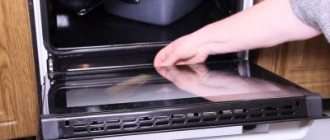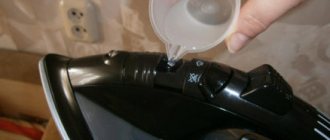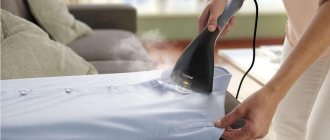How to use a furniture stapler: device, operation, tips
A furniture stapler is a fairly universal tool with which you can not only perform furniture upholstery procedures, but also a number of other construction operations.
Today, there are several types of similar equipment, differing in their operating principle:
- pneumatic,
- electric,
- manual.
Pneumatic staplers are used in industry, and electric and manual staplers are used in everyday life. Models belonging to the latter type are the most common in the furniture industry due to their mobility and ease of use. Let’s use this example to look at the principle of operation, operation and repair of furniture staplers.
However, before moving on to this procedure, I would like to say a few words about staples and their varieties.
How to refill a mechanical stapler?
Furniture staplers are divided into three types:
- mechanical;
- electrical;
- pneumatic.
It is necessary to take into account the specifics of refilling the tool, which directly depends on its moving mechanism.
The design of such staplers is not much different from each other. They consist of a lever handle, through which mechanical pressure is applied, and at the bottom of the tool there is a metal plate that opens the receiver. This receptacle can accommodate staples.
The mechanical type is driven by the applied force of the hands, which indicates their weak power. The model contains a small number of staples. With their help it will not be possible to nail hard and thick structures. However, such assistants are light in weight and compact in size, so they will be needed for processing hard-to-reach places. The mechanical type of stapler is available due to its low price, is compact for carrying and easy to maneuver.
To insert staples into a mechanical stapler, you must follow these steps:
- To refill the stapler, you must first open the plate. To do this, you should take it on both sides with your thumb and forefinger, and then pull it towards you and down a little. Due to this, the metal tab located on the back of the plate will be pressed out.
- Then you need to pull out a metal spring, similar to the one found in an ordinary office stapler. If the staples are still loaded, they will fall out of the stapler when the spring is pulled out.
- The staples must be inserted into the receiver, which looks like a U-shaped hole.
- Then the spring is returned to its place and the metal tab is closed.
After completing these steps step by step, the tool will become suitable for further use.
Not just parentheses
Some staplers can work not only with staples, but also with studs of various shapes. The designations of what the stapler works with are indicated on its body or in the instructions.
I tuck the nails into the stapler in the same way as with staples, but you need to be careful after pulling out the spring. A row of nails must be loaded along one of the outer edges of the letter “P”, and not inside this very letter!
If you want it to produce two nails side by side when working with a stapler, load the second row along the second outer edge. Next, the spring is inserted and the stapler is closed.
A stapler (translated from English as “stitcher”) is a necessary thing in everyday life and at work. A stationery stapler is designed for fastening sheets and files. There are five types of staplers: manual, manual office, desktop horizontal or vertical, stitching, printing. They all differ, first of all, in the number of sheets that can be stitched at a time.
You will need
- – stapler;
- – staples.
Instructions
1.
Determine what type of stapler you have. To do this, see how many sheets you can sew at a time. The most primitive in design are pocket staplers. They are prepared for stapling up to 10 sheets. Manual office ones have a special recess on the fingers and allow you to fasten up to 30 sheets. Tabletop horizontal or vertical ones have a rubber or plastic sole; they sew up to 50 sheets. Stitching machines allow you to staple up to 150 sheets, while printing machines, which have a maximum stitching depth, can bind up to 250 sheets at a time. The specificity of stapling with a stapler is through fastening, which you carry out using a metal staple. The staple pierces the sheets being stapled right through, and its ends rest against the plate located at the end of the other side of the stapler.
2.
Before loading the stapler, determine the size of staples that is suitable for it. Staples (also called paper clips) come in several types: No. 10, 26/8, 26/6, 24/8, 24/6. These numbers are written on the packaging. Staples must be packaged in cardboard boxes of 500, 1000 or 2000 pieces. You will find out which of the above are suitable for your stapler by looking at its packaging.
3.
In order to load the stapler with the selected staples, bend its cover. It is connected by a spring to a plastic element, the one that presses the staples to the opposite edge of the metal groove, the one that holds the staples. Opening the cover will pull the spring and, consequently, the plastic element, thus freeing up space for new staples.
4.
Take one section of staples and place them in the metal groove, ends facing down. Close the lid and click the stapler once to test. If a staple with concave ends inward falls out of it, it means you did everything correctly, but if this did not happen, or the staple was bent abnormally, then repeat the procedure or change the stapler.
Using a stapler without any nails, you can fasten materials of small width and density. It is an indispensable tool in the office, construction and furniture industries. In this article we will figure out how to insert paper clips into a stapler.
Possible mistakes
There are several of the most common, frequently encountered errors and problems that accompany the operation of a furniture stapler. The tool may fire multiple staples at once, or not at all, and may damage upholstery material. Errors are due to the following reasons:
- incorrect pre-adjustment of the adjusting screw when performing work with traditional mechanical models of the device;
- neglect of the rule of advance marking of places for installing staples, which allows for high-quality and uniform tension of upholstery material;
- lack of fixation of the upholstery with a free hand in order to prevent the material from moving during operation with a stapler.
It is important to control the number of staples inside the “magazine” of the tool, and also be sure to secure the handle with a safety lock immediately after finishing work. This will prevent spontaneous or accidental shooting.
It is strictly forbidden to work with a faulty tool. If necessary, the problem is diagnosed, and the firing pin that has exhausted its life is also periodically replaced.
Many people forget
Before work, adjust the adjusting screw according to the material of the surface you are going to work with.
If it is hard plywood, strong penetration of the material will be required, therefore, it is worth setting a high force. If it is a loose surface, the force must be reduced so as not to break through the fabric, or for example the PVC panel that you are shooting.
During operation, it is recommended to press the lever with one hand and press the adjusting screw with the thumb of the other hand. Then the recoil will be minimal and the load will be distributed evenly in the stapler. You will be able to nail the brackets much better.
Pneumatic construction staplers
Differences from mechanical and electrical devices:
- Pneumatic staplers are used for serious work on an industrial scale. They are distinguished by high speed (50-60 beats per minute) and power of charge delivery.
- Long staples and nails may be used.
- The weight of the gun is comparable to an electrical unit operating from an outlet.
- Another device design. There is no spring here; the charge is clogged by the force of air compression.
- Disadvantages: dependence on electricity and compressor. Such instruments can be considered stationary.
- When purchasing, you need to know the pressure for effective operation. The minimum value for pneumatic staplers is 4, the standard is 5-6 bar.
- The cost of devices is much higher than their electrical and mechanical counterparts.
Preparing the tool for work
In our case, a mechanical stapler will be used to attach the foam rubber and upholstery fabric to the bench seat. To do this, you need to choose the right fasteners . Depending on the thickness of the foam rubber, choose brackets that, when fastened, will grip the material itself and the base. It is better to take large ones, 14 - 16 mm in size, so that the material is securely fixed. But remember that the size of the staples should not exceed the maximum allowable for the tool you are working with. Otherwise, you won’t be able to insert them into the magazine, and if you do, there is a high probability that they will get stuck.
The choice of fasteners for nailing upholstery depends on what material you will use:
- For velvet, flock, cotton or linen, you need small staples, 4–6 mm in size (they will not damage the thin fabric and will fix it well).
- For denser materials, such as leather, suede, microfiber , staples measuring 8 - 10 mm are suitable.
Remember that it is better to buy branded consumables . After all, low-quality fasteners can damage the product or cause damage to the tool itself. Original staples will not get stuck in the stapler, will not break or bend, they fit perfectly into the material the first time, so they are used very economically.
Remember your safety! When working with sharp staples and nails, use personal protective equipment . Be sure to wear gloves so that if fasteners accidentally fly out, your hands are protected. Also, this will help prevent your palm from slipping, which is very important when carrying out such painstaking work as upholstery.
Characteristics and types of furniture brackets
The main indicator that is taken into account when choosing a bracket is its depth. Depending on the nature of the work performed, this indicator can vary from 4 to 14 millimeters.
So, for example, in order to carry out the procedure of upholstering furniture with fabric, a staple with a depth of 8 millimeters will be sufficient, while for fixing thicker materials, a staple with a greater depth should be selected.
Also, depending on the overall dimensions, staples are divided into the following types:
- 53 - is the most common. Staples of this type have a width of 11.4 millimeters and a thickness of 0.7 mm. The depth of this fastening element varies from 4 to 14 millimeters;
- 140 – having the following characteristics: width – 10.6 millimeters, thickness – 1.2 mm, depth – similar to the previous type;
- 36 – this marking means that the stapler can shoot staples that have a semicircular shape and are mainly used for cable installation;
- 300 - These are special nails intended only for the stapler.
When choosing a bracket, you should also take into account the structure of the material from which it is made.
Safe work techniques
Using a mechanical stapler.
By following safety precautions when using the device, you will avoid unnecessary injury. And the device will last longer:
- Before replacing staples, you need to put the tool on safety. This way he won't shoot by accident.
- Do not point the stapler at yourself or other people or animals.
- When transporting or storing the device, always switch the safety switch on.
- The tool can only be used in a sober mind. Persons in a state of intoxication are prohibited from handling a stapler.
- The work place should be well lit.
- Care must be taken to ensure that staples hit metal surfaces to avoid rebound. It is important to use special glasses to prevent the charge from flying into the eye.
- If the fastener is stuck in the product and is not completely clogged, you must carefully remove it.
- If small parts are used in the work, they need to be clamped in a vice. Driving staples into small surfaces directly in your hand is very dangerous.
- During work, the body position should be natural, clothing should be comfortable, and the sole should not slip.
When working with an electric or pneumatic stapler, you must follow the safety rules described for mechanical tools. More important:
- An electric stapler cannot be used indoors if there is a risk of explosion;
- you need to make sure that the switch on the device is off before plugging the cable into the outlet;
- the device body, electrical cable and plug must be undamaged;
- The power tool cannot be used outdoors during rain and snow, or indoors in high humidity;
- there should be no people or animals in the work area;
- all components of pneumatic tools must be in good working order and not damaged;
- During operation, the power cable must not come into the worker's area.
Mechanical, electric or pneumatic staplers are easy to use. But it is important to use the tool correctly. You need to charge it with fasteners with the markings indicated for your model. It is also necessary to adjust the mechanism for the required force of driving in staples. The main thing: follow safety rules when using. Careful handling and careful use are the key to productive work with any stapler.
Video “Master class on replacing staples in a stapler”:
open the box of staples, take a batch of staples, open the stapler, insert the staples, pointy ends down.
I don’t know if the procedure for inserting staples is the same in all staplers, but I just looked at my stapler and can write this:
- Open the stapler
- Pull the spring device that held the brackets in position downwards,
- Insert the brackets into the space provided (so that you get the letter P standing on a support, and not upside down),
- Slowly return the spring to its place and it will rest against the brackets.
- Close the stapler.
A construction stapler is a multifunctional mechanism. It is used when it is necessary to connect identical or different not particularly hard materials to each other, for example, plastic, wood, film, insulation, plywood. This tool is called differently: tacker, staple gun, staple gun, nailer, staple gun. The individual elements are fastened to each other using staples, pins or small nails. To know how to properly work with a construction stapler, you need to understand its design, the types of fasteners suitable for it, and the method of setting up and replacing staples.
How to choose a construction stapler
The technical characteristics of a construction stapler depend on the type chosen. Staplers are classified according to the type of driving force. There are three types of construction staplers:
- Mechanical construction stapler. Works due to mechanical force. By pressing the trigger, the spring inside the stapler is activated, driving the staple into the material with great force. The disadvantage of a mechanical stapler is its low efficiency when working with hard materials; however, it is compact, lightweight, and easy to carry with you in a standard tool box.
- Electric construction stapler. The same trigger sets the spring in motion, but this tool no longer requires mechanical force; the power source is electricity. Staplers are available in two types: mains-powered and battery-powered. Each stapler has its own advantages and disadvantages: a network stapler is more powerful and will not shrink at the right moment, but the electric wire gets in the way; The battery-powered model eliminates the risk of the cable being punctured, but the battery makes the tool heavy and bulky.
- Pneumatic construction stapler. It works due to the high pressure created by pneumatics inside the stapler. They have high performance, but due to the heavy compressor, they are stationary, and are more often purchased for industrial purposes than for home use.
In addition to the type of driving force, it is customary to distinguish between professional and household tools. Household staplers are short-lived and are made mostly of plastic. Professional staplers are designed to last a long time and have a long service life. For home and household needs, I recommend purchasing semi-professional hand tools; they are made from high-quality materials, will last for many years, but will cost several times less than professional tools.
Which to choose?
Construction staplers are divided into several types according to certain parameters. For example, according to the principle of operation - mechanical, electric and pneumatic tools.
By purpose:
- Typical (classic) stapler. It usually uses U-shaped staples, but special nails can also be installed. It has a universal purpose.
- The cable stapler is capable of securing cables and wires with a diameter of up to 8-10 mm, for which rounded staples are used. Such fastening can be carried out in electrical networks with a voltage of no more than 50 V. At higher voltages it cannot be used due to the risk of a short circuit. The main purpose is telephone, computer, communication lines.
- The packaging tool is designed to work with cardboard (including corrugated cardboard) and various film materials. It resembles a stationery device, because... bends the ends of staples, but has significantly greater power and size.
- The window option is capable of securing glazing beads and other elements using metal pins. The length of these fasteners can range from 10 to 50 mm, depending on the principle of operation of the stapler.
- Thacker uses V-shaped staples. This fastener design allows you to connect workpieces located at an angle to each other. An example of use is assembling photo or painting frames.
- The rivet stapler (rivet gun) is capable of installing aluminum, copper and steel rivets.
- The staple hammer uses the inertial principle, i.e. it is used like a hammer, but the impact force is increased due to a special mechanism. The main purpose is installation of roofing and floor coverings.
According to technical characteristics:
- Impact force. This is an important criterion for choosing a tool, because it determines the depth of driving in the fastening element (staple, nail). For household construction, this parameter is in the range of 3-16 mm. Low-power tools work with staples up to 8 mm high, while higher-power tools work with staples higher than 10 mm.
- Bracket width. The area of pressing of the elements when they are fastened depends on this indicator, and therefore the speed of the operation and the reliability of the connection.
Mechanical
The most widely used mechanical stapler is the operating principle of which is based on increasing physical strength using a spring mechanism. During operation, the user presses the handle with his hand, which bends the spring.
At the maximum point of bending, the spring is released and all its accumulated energy is directed to strike the fastening element (clip, pin or nail). This force is enough to drive it into the base.
The spring in a mechanical stapler can be of a twisted or plate (spring) type. When choosing a tool, it is better to give preference to the second option, because it provides significant impact force with almost complete absence of recoil. In modern designs, the impact force is adjustable, which makes it possible to configure the tool to work with materials of different hardness.
Electric
An electric stapler differs from a mechanical tool in that the spring bends using electricity. When you turn on the device, it immediately enters the ready state, and to strike the bracket you just need to press the start button. This stapler can operate from mains power or a built-in battery.
Usually, preference is given to battery power, because... The connection to the outlet is eliminated and there is no cord that interferes with operation. The most commonly used batteries are nickel-metal hydride type (2 cells at 14.5 V) and lithium-ion type at 18 V. The second type of battery is the most reliable.
The main advantages of an electric stapler are the elimination of physical effort, which is important for large amounts of work; acceleration of work; convenience and practicality. Disadvantages - higher cost, less reliability and greater weight of the tool
Pneumatic
In a pneumatic stapler, the shock load is provided by compressed air. Such a tool can be produced in stationary and manual versions.
In the first case, the air supply is regulated by the pedal, and in the second - by the start button.
To operate a pneumatic tool, you need an air compressor, which creates the main disadvantage - the bulkiness of the equipment.
Among the positive aspects of this stapler, there is a locking system against accidental inclusions, prevention of jamming of staples, and adjustment of shock load. The most important advantage is the highest speed of operation and enormous penetrating ability.
Advantages
The tool has a number of undeniable advantages , regardless of the type of stapler used:
- Reliability and high degree of safety when working with the tool.
- Thanks to the use of a stapler, you can significantly save your energy and time in the process of repairing or reupholstering furniture, as well as when carrying out other specific repair and construction work.
- The convenience is that you can operate the device with only one hand.
- The device, regardless of its type, is easy and simple to use. That is, no special skills are required when working with a stapler.
- All risks associated with the likelihood of mechanical damage to the product to which the device is used are minimized.
- Installation using a stapler takes much less time than when working with nails and a hammer.
- When stitching with a tool, you can use different types of material.
- With proper operation, the device can operate uninterruptedly for a long time.
- Thanks to the powerful impact force, the workpiece always remains in its original form.
- The tool is very multifunctional, since various stapler models can use not only staples, but also nails or screws as consumables.
- Materials for stitching products are not subject to corrosion.
- The tool can be used even in hard-to-reach places.
It should be noted that for household needs you should always choose a mechanical device. It is easy to use and maintain and, importantly, has an affordable price.
What to do if a staple gets stuck in the stapler
Single staples often get stuck at the output of the receiver - this is due to the simplicity of the mechanism for pressing them. If such a problem is detected, you should carefully and slowly push out the object with something sharp. A paper clip, thin knife or needle will do. If the jam is severe, you will even need tweezers, especially if the consumable is small.
For ease of operation and to avoid pressing unused staples, you may need to pull out the clamping mechanism. The jammed element will then protrude from the feed mouth; it can often be pulled out by hand.
When using an auxiliary tool, you should hold the products with the working sides down - this way you will not get injured if you fall or the mechanism is triggered.
Options
If it was not possible to change it quickly and immediately, we recommend checking the entire mechanism:
- if the bracket fires weakly, you need to check the spring - it weakens over time, and even gets knocked down a little when reloading;
- if the staples do not come out at all, it is very likely that the problem is in the striker: it is often rounded and requires regular sharpening;
- sometimes consumables fly out slightly bent - the special bolt is tightened too much;
- It happens that the staples themselves do not fit - if you replace them with ones made of a different steel, the result will change.











